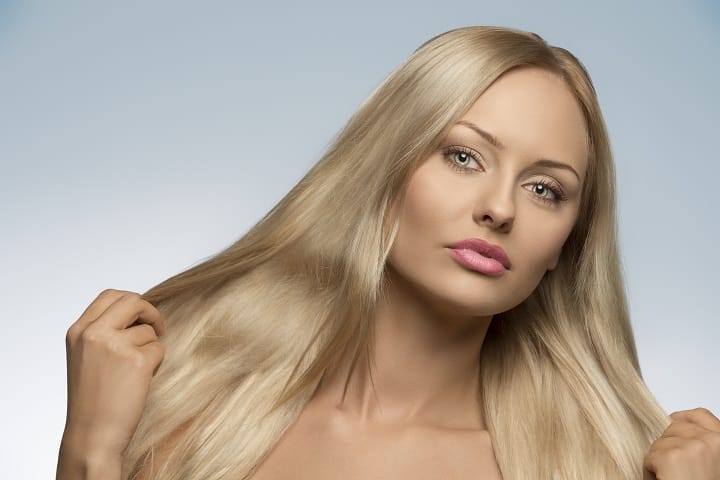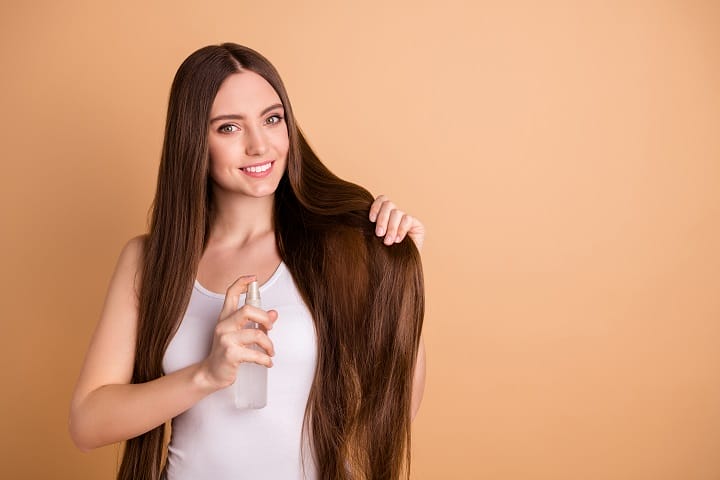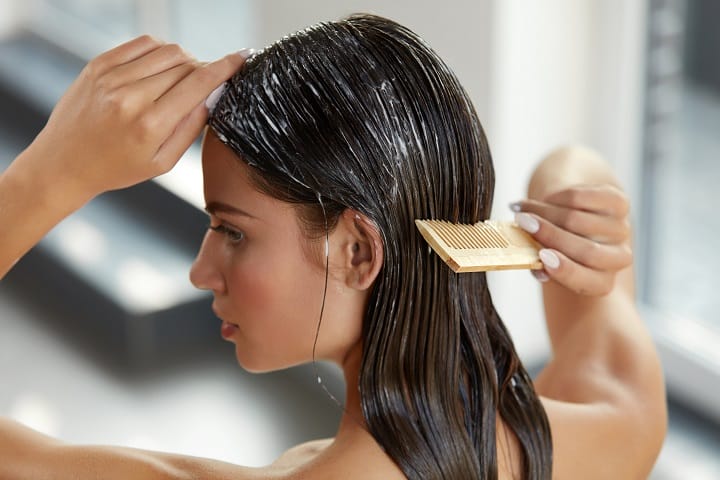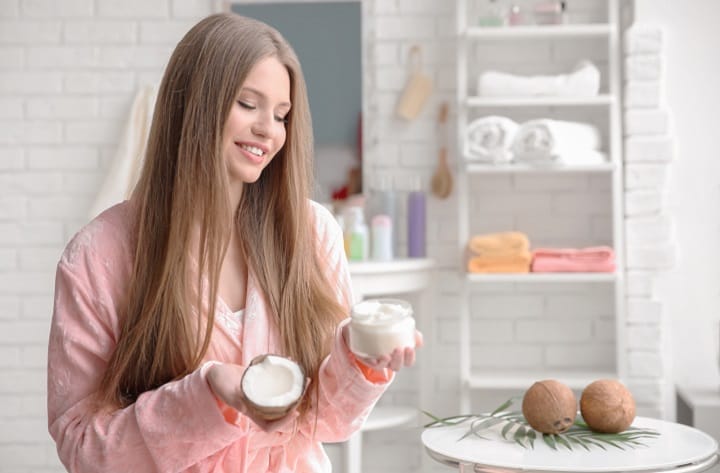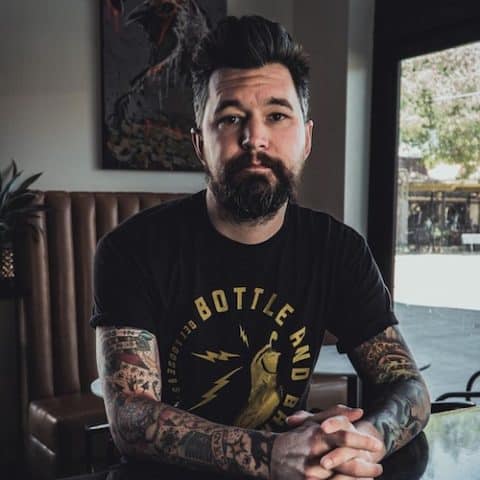Do you want to make your bleached hair soft and silky?
The most common complaint for those whose hair went through a bleaching process is that their strands get dry and frizzy.
Bleaching may also cause some damage to your hair that may remove its softness and shine.
Through this article, find out how to keep your hair soft and silky even after bleaching.
Table Of Contents
Does Bleaching Hair Damage It
Yes. Bleaching or highlighting your hair can be damaging to your strands. The entire process uses chemicals and other properties that can be harsh to your strands.
They may cause your hair to get brittle, dry, frizzy, and vulnerable to breakage. This is why many opt for bleach-free hair lightening, which is safer and gentler on hair strands.
Bleaching can cause damage as it tends to raise your hair’s outer cuticle, making it possible for the bleaching agent to penetrate it thoroughly.
Constant bleaching may raise the hair cuticle permanently, leading to the quick and continuous loss of moisture from your hair strands.
Bleached hair can also be expected to become more porous, which means they are more prone to both non-chemical and chemical hazards, like heat styling, as well as the harsh effects of rain, wind and sun.
13 Best Ways to Make Bleached Hair Soft and Silky
Deep Condition
Bring back the softness and moisture on your hair by regularly applying and using a deep conditioner. Make sure that you choose a deep conditioner designed specifically for hair that underwent the bleaching process.
Apply the deep conditioner on your hair once or two times weekly. It can help repair your hair cuticles and bonds that may have been damaged because of bleaching.
Hydrating Shampoo
After the bleaching process, you should be willing to trade your usual shampoo with a hydrating one, like green tea or olive oil, as part of their major components.
You need this shampoo as the bleaching process may cause your hair to become lifeless and lose moisture. You may also use a shampoo specifically meant to repair hair damage. Ensure that your chosen shampoo is free of sulfate, too.
Leave-In Conditioner
Another tip to restore the shine on your hair after bleaching is to put on a leave-in conditioner every day. This hair product is available in many supermarkets and beauty stores and aids in reviving hair damaged by bleach.
You can go for those thick types of leave-in conditioners you can apply when you are in the shower. There are also spray-on leave-in conditioners that you can use on your hair immediately.
When searching for the best leave-in conditioner, go for those that have keratin-building and moisturizing properties.
Minimize Heat Styling
Similar to how important it is to wash your hair after coloring with the right products, it is also vital to avoid styling your hair using too much heat if it goes through a bleaching process.
Keep in mind that after you have bleached your hair, it tends to become dry and prone to more damage prompted by heat styling. With that in mind, lessen the frequency of blow-drying, straightening or curling your hair using hot tools.
This should be avoided entirely during the first couple of weeks after bleaching. Once you feel like you can already reintroduce hair styling through heat, minimize it. Do it one to two times every week instead of daily.
Air-Dry as Often as Possible
Instead of drying your hair with a blow-dryer, air-dry it since it is safer and gentler on your bleached hair. The same technique applies when caring for new hair color ideas and styles you have tried and if you are dying wet hair.
If you really need to dry your hair with a blow-dryer, use one meant for damaged hair. It should also be at the lowest setting.
Use a Sulfate-Free Shampoo
You also need to use sulfate-free shampoo for your bleached and color-treated hair. The reason is that sulfates are rich in salt that may only further damage your hair. Before buying a shampoo or any other hair product, take time to check and read the labels.
Stay away from those that have sodium lauryl sulfate. Aside from being sulfate-free, the shampoo must also be formulated for color-treated, such as pink ombre hair.
Gentle Brushing
Remember that bleached hair is more sensitive and prone to damage than unbleached strands. To avoid damage, brush your hair gently, especially when wet. Also, go for a wide-tooth brush or comb, and avoid pulling or tugging at your hair.
Protect Hair From Possible Sun Damage
Too much sun exposure can be highly damaging to your hair, especially if it goes through treatment like bleaching. You should, therefore, work on protecting your hair from possible sun damage by wearing a hat or applying a UV-protectant hair product.
This product can protect your tresses and lessen the possible damage that UV rays may cause.
Apply Argan Oil
You can also fight hair dryness that results from bleaching. With its high antioxidant and moisturizing properties, the oil can help restore your hair’s natural shine even after the bleaching process.
You can also start using shampoo and conditioner that contains argan oil, so your strands will receive more nourishing vitamins.
Hair Masks
Make it a habit to apply hair masks on your tresses. Go for a hair mask containing moisturizing properties and ingredients, such as apple cider vinegar, black seed oil, red onion, and coconut milk, to make your hair elastic again.
Apply the mask from the hair ends to the roots. For those with oily scalps, though, the roots should be avoided. Leave the mask for around fifteen to twenty minutes before thoroughly rinsing it with cold water.
Oil Massage
Give hair damaged by bleach a relaxing massage using oils guaranteed to be good for each strand. You may use argan, castor, jojoba, grapeseed, olive, sweet almond or other good and healthy oils for the hair.
You can combine a few drops of these oils to restore your hair and its life and moisture.
Leave-In Treatment
Another valuable tip to improve the health and look of your bleached hair is to give it a leave-in treatment. This can help a lot in making your hair smooth and soft again.
In this case, a mist tonic or revitalizer spray will greatly help revive hair and strengthen it. It can also nourish your hair and make it shine once again.
Prevent Breakage at Night
Whether you have mixed girl hairstyles or any other bleached hairstyle, you must make it a point to protect each strand every night from breakage.
One hair care routine you can do every night would be to apply an overnight mask, which would help hydrate your hair more.
It also helps to pull your hair back to give it a protective style before sleeping. One more thing you can do is use a satin or silk pillowcase, which has a gentle texture that will prevent your hair from forming frizz or snags overnight.
All these can protect your hair from breakage as you sleep each night.
Home Remedies for Softening Bleached Hair
Aside from the mentioned solutions, you also have a better chance of revitalizing your bleached hair with the aid of these home remedies:
Essential Oils
If your hair becomes too dry because of bleaching, you can improve it with the help of essential oils. A great choice is argan oil, which you can apply at the ends to give your hair a softer and supple look.
To prevent breakage and hair loss, you can also use lavender and peppermint oil, among other essential oils. You can mix peppermint, lavender, and argan oil with coconut or other carrier oil.
The mixture can give you a hair perfume, which you can quickly spritz on your hair to make it soft and silky again.
Coconut Oil
The fact that coconut oil can be classified as a natural emollient means that it is also good for your hair, especially if it goes through treatment like bleaching. Coconut oil can fill any gap in your strands, particularly those damaged by the sun, heat, and bleach.
It can also penetrate your hair fibers. It can smoothen your hair. All you have to do to get all these benefits is to make it a weekly habit to deep condition your hair using warmed coconut oil.
Lukewarm or Cool Water
Note that hot water may only elevate your strands’ cuticles, making them lose moisture quickly and leading to weak and dry hair. Retain your hair’s strength and moisture even after bleaching by rinsing using lukewarm or cool water. It can also give your locks some shine.
Useful Tips and Tricks
- Use high-quality hair ties – Avoid traditional hair ties that can only be damaging to your hair as they tug on the strands, causing them to break.
- Use a wet brush after washing your hair – The brush should have flexible bristles. Alternatively, you can use a wide-toothed comb. Both of them can help prevent breakage, tangles, and snags that are common on bleached hair.
- Trim your hair regularly – This is necessary for hair that has become excessively dry and coarse and started showing a lot of split ends. A trim can make your hair go through a reset and give it a fresh cut.
- Do not wash and shampoo your hair every day – While a shampoo can help get rid of sweat and dirt from your hair, it also causes your strands to get stripped of sebum, its natural oil. The recommended frequency for shampooing is every other day or two to three times weekly.
- Do not use hot tools for styling – You may need to avoid heat styling your hair for a while if you decide to have it bleached. Even if it is already safe for you to style your hair using heat, keep it at a minimum since it is often one of the significant causes of hair damage and dryness.
FAQ
Can bleached hair be repaired?
Yes, there are a few things that you can do to repair hair damaged by bleach. You can even visit a salon that recommends a keratin treatment.
The goal is to add keratin to your hair, which is its critical structural component. This can somehow restore its shine and moisture.
Can the damage be avoided while bleaching hair?
Hair bleaching can be harsh to one’s hair, so possible damage may be pretty challenging to avoid. What you can do is lessen the possible damage.
One thing that you can do to minimize the damage is to prepare your hair using a conditioning treatment before the bleach application. Ensure that you give your hair proper care after the procedure.
What are some tell-tale signs of bleach-damaged hair?
One sign that your hair is damaged because of bleaching is when it loses its natural shine. You may also notice your hair falling out and becoming prone to breakage. Other signs of bleach-damaged hair are split ends, dryness, tangles and frizz.
What is the best way to condition hair after bleaching?
If your hair goes through a bleaching process, rescue it from potential damage by increasing your use of conditioning products.
Apply a conditioner right after every shower. Use conditioning oils, too, like olive oil or coconut oil. Make it a part of your hair treatment every week.
A daily leave-in conditioner can also give your locks more softness and smoothness. Invest in a purple conditioner, too, which is designed explicitly for bleached hair.
It can eliminate your hair’s darker tones and brassiness while preventing frizz and providing enough hydration.
What oils work best on bleached hair?
Among the most nourishing oils you can use for bleached hair are olive oil, coconut oil, and argan oil. These oils can restore your hair’s shine and softness while keeping each strand strong and fully hydrated even after bleaching.
How to make bleached hair look shiny?
You need to condition your hair deeply regularly to bring back its shine. It is also advisable to use only haircare products that contain moisturizing and hydrating properties.
Make sure you also use essential oils guaranteed to nourish and moisturize your hair.
Anthony Giannotti is a senior writer and editor for Beardoholic and a licensed barber for more than 13 years. He owns 3 barbershops and has his own hair care product line that is sold in barbershops worldwide. Known for his impeccable technique and skills, Anthony is an expert in hair and beard care and he knows the best products and tools to get rid of all beard problems and have an amazing beard.

